Você precisa desativar todos os plug-ins do WordPress, mas não consegue acessar a área de administração do WordPress?
Durante a solução de problemas do WordPress, você será frequentemente aconselhado a desativar todos os plug-ins e depois reativá-los um a um. Mas e se você não conseguir acessar o wp-admin para desativá-los?
Neste artigo, mostraremos como desativar facilmente todos os plug-ins do WordPress quando não for possível acessar a área wp-admin.
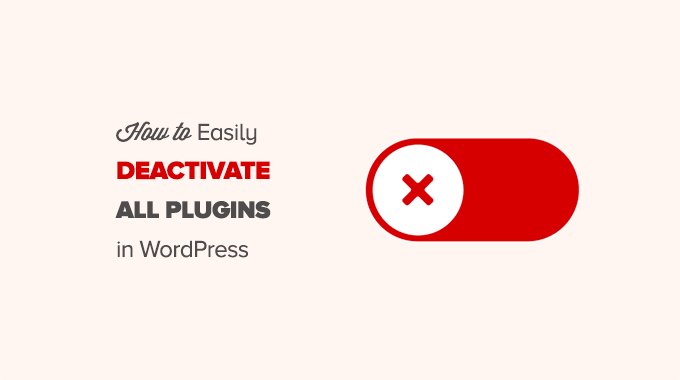
Tutorial em vídeo
Se preferir instruções escritas ou quiser seguir seu próprio ritmo, continue lendo as instruções abaixo.
Há dois métodos comumente usados para desativar plug-ins sem acessar a área de administração do seu site WordPress. Você pode escolher o método que lhe parecer mais fácil:
Método 1: Desativar todos os plug-ins do WordPress usando FTP
Para esse método, você precisará usar um cliente FTP ou o aplicativo gerenciador de arquivos no painel de controle da hospedagem do WordPress.
Se você nunca usou o FTP antes, consulte nosso guia sobre como usar o FTP para fazer upload de arquivos para o WordPress.
Primeiro, você precisa se conectar ao seu site usando um cliente FTP ou o gerenciador de arquivos no cPanel. Depois de conectado, você precisa navegar até a pasta /wp-content/.
Dentro da pasta wp-content, você verá uma pasta chamada plugins. É nela que o WordPress armazena todos os plug-ins instalados em seu site.
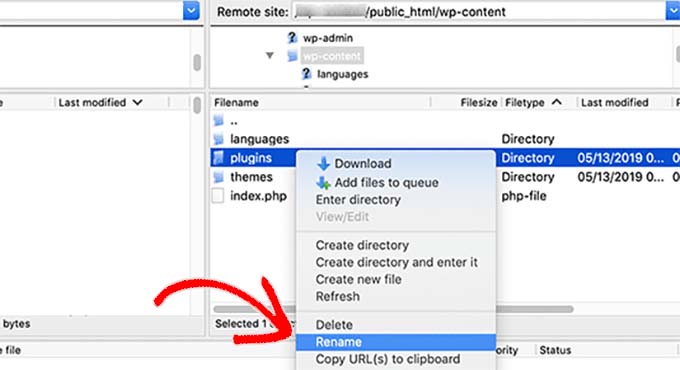
Você precisa clicar com o botão direito do mouse na pasta de plug-ins e selecionar “Renomear”.
Em seguida, altere o nome da pasta para o que você quiser. Em nosso exemplo, nós a chamaremos de plugins.deactivated.
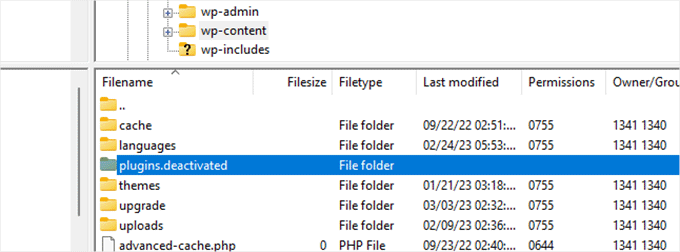
Depois de fazer isso, todos os seus plug-ins serão desativados.
Isso ocorre porque o WordPress procura uma pasta chamada “plugins” para carregar os arquivos de plugin. Quando não encontra a pasta, ele desativa automaticamente os plug-ins ativos no banco de dados.
Normalmente, esse método é usado quando você está bloqueado fora da área de administração. Se o problema for com os plug-ins, você poderá fazer login na área de administração do WordPress.
Se você visitar a página Plugins ” Plugins instalados na área de administração do WordPress, verá notificações de todos os plug-ins que foram desativados.
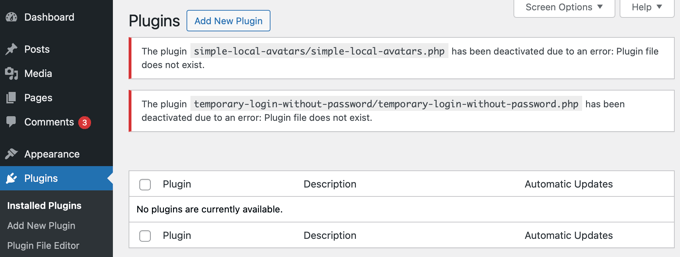
Você também perceberá que todos os seus plug-ins desapareceram. Não se preocupe; todos eles estão seguros e você pode restaurá-los facilmente.
Basta voltar ao seu cliente FTP e acessar a pasta /wp-content/. A partir daí, você precisa renomear a pasta plugins.deactivated de volta para plugins.
Agora, você pode voltar à página Plug-ins ” Plug-ins instalados na área de administração do WordPress e ativar um plug-in por vez até que seu site volte a funcionar.
Nesse ponto, você saberá exatamente qual plug-in causou o problema. Em seguida, você poderá excluir a pasta desse plug-in do seu site usando FTP ou solicitar suporte ao autor do plug-in.
Método 2: Desativar todos os plug-ins usando o phpMyAdmin
O método FTP é definitivamente mais fácil, em nossa opinião. No entanto, você também pode desativar todos os plug-ins do WordPress usando o phpMyAdmin.
Importante: antes de fazer qualquer coisa, faça um backup completo do banco de dados. Isso será muito útil se algo der errado.
Em seguida, será necessário fazer login no painel de controle da hospedagem na Web. Neste exemplo, estamos mostrando um painel do cPanel. O painel de sua conta de hospedagem pode ser diferente.
Você precisará clicar no ícone “phpMyAdmin” na seção Databases (Bancos de dados).
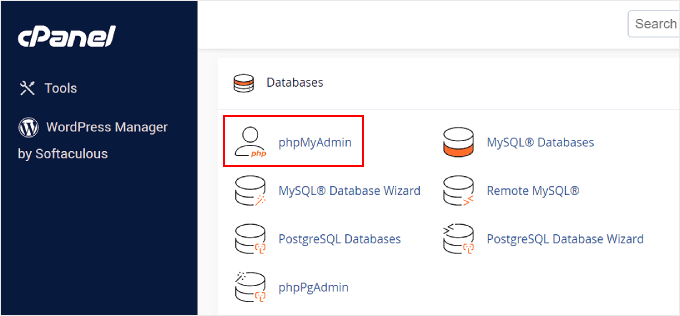
Isso iniciará o phpMyAdmin em uma nova janela do navegador.
Você precisará selecionar o banco de dados do WordPress, se ele ainda não estiver selecionado. Depois disso, você poderá ver as tabelas do banco de dados do WordPress.
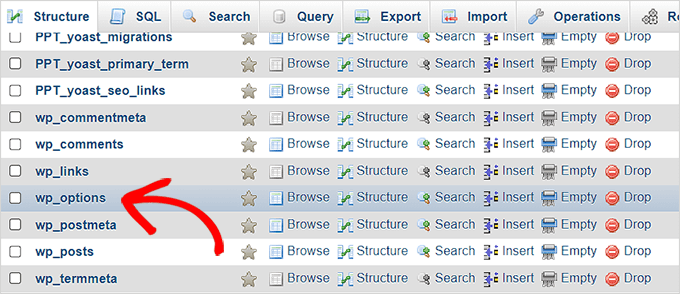
Como você pode ver, todas as tabelas no banco de dados têm o prefixo wp_ antes do nome da tabela. Suas tabelas podem ter um prefixo de banco de dados diferente.
Você precisa clicar na tabela wp_options. Dentro da tabela wp_options, você verá linhas de diferentes opções. Localize a opção “active_plugins” e clique no link “Edit” (Editar) ao lado dela.
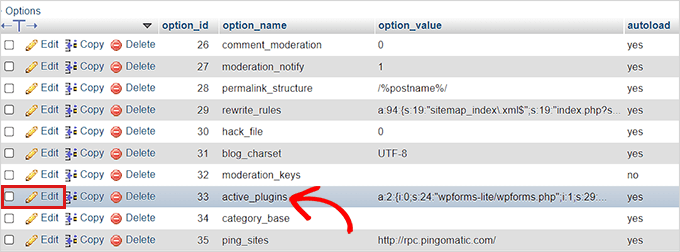
Na próxima tela, você precisará alterar o campo option_value para a :0:{}.
Em seguida, clique no botão “Go” (Ir) para salvar suas alterações.
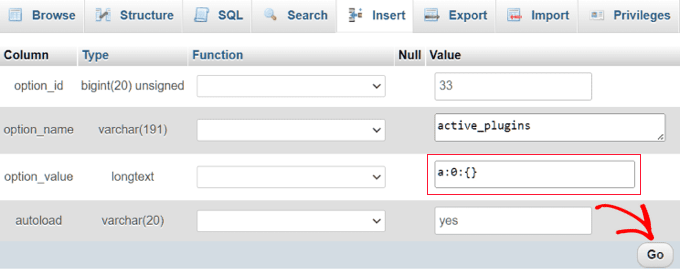
Você desativou com êxito todos os plug-ins do WordPress usando o phpMyAdmin. Se um plug-in o estava impedindo de acessar o administrador do WordPress, você deve conseguir fazer login agora.
Guias especializados sobre plug-ins do WordPress
Agora que você sabe como desativar plug-ins quando não consegue acessar o wp-admin, talvez queira ver outros guias relacionados a plug-ins do WordPress:
- O que são plug-ins do WordPress? E como eles funcionam?
- Como desativar facilmente os plug-ins do WordPress (guia para iniciantes)
- Como habilitar/ativar plug-ins do WordPress a partir do banco de dados
- Os plug-ins inativos tornam o WordPress mais lento? Você deve excluí-los?
- Quantos plug-ins do WordPress você deve instalar? O que é demais?
- É seguro usar plug-ins desatualizados do WordPress? (Explicado)
- Você deve instalar plug-ins que não foram testados com sua versão do WordPress?
- Como atualizar corretamente os plug-ins do WordPress (passo a passo)
- Devo atualizar o WordPress ou os plug-ins primeiro? (Ordem correta de atualização)
Esperamos que este artigo tenha ajudado você a desativar todos os plug-ins no WordPress. Você também pode querer saber como configurar as metas do Google Analytics ou conferir nossa lista dos melhores plug-ins de backup do WordPress para manter seus dados do WordPress seguros.
Se você gostou deste artigo, inscreva-se em nosso canal do YouTube para receber tutoriais em vídeo sobre o WordPress. Você também pode nos encontrar no Twitter e no Facebook.





Syed Balkhi says
Hey WPBeginner readers,
Did you know you can win exciting prizes by commenting on WPBeginner?
Every month, our top blog commenters will win HUGE rewards, including premium WordPress plugin licenses and cash prizes.
You can get more details about the contest from here.
Start sharing your thoughts below to stand a chance to win!
ARoibal says
I am really thankful that you posted this article. I had no idea how to fix the problem and in my case it was a plugin. Thank you!!!!
Robb Dearth says
I usually don’t comment on posts like this, and I know this post is insanely old (by today’s standards) but I just wanted to thank you for this quick fix. I was able to access the /plugins folder via Media Temple’s file manager, change the folder name, and target the problem plugin… THANK YOU!!!
Cindy says
I could not get into my blog at all to edit anything. I followed your directions on deleting a plug-in. That fixed it. Thank you for the info and for explaining it in a way that is easy to understand!!
WPBeginner Support says
Thanks, glad you found it helpful.
Administrador
Jairo Levi says
Super! I was able to fix my site by renaming the Plug ins folder, then re activating the plug ins one by one.
Just wanted to say thank you!
Jairo.
WPBeginner Support says
You are welcome
Administrador
Dennis says
Hello thanks so much for the article,
i was developing my wordpress offline using wampserver localhost.
When i finished it worked just fine on my localhost but after uploading it i started having the issue, only the index page could load and every other page still have the offline url ( that is localhost/mysite/thepost) when i manually change the localhost url to the normal url it ought to be, i gets a 500 Internal Server Error.
I’ve tried all method mentioned here but my problem persist.
Please I really Need help.
Thanks so much.
Franck says
Great article! saved me a headache. Had to go through the whole process but was worth it. Now my site is back and everything up to date. Great job guys!
Paolo Euvrard says
Great info, it worked!!!
Cheers
maros says
ssh:
debian@otherland:*/wp-content/plugins$ sudo chown root:root menu-icons/
debian@otherland:*/wp-content/plugins$ sudo chmod -R 700 ./menu-icons/
debian@otherland:*/wp-content/plugins$
then I reloaded “tab with server error 500” and it said to me something like plugin deactivated …files not found.
Brian H says
Try clearing your cookies and cache, then see if you can get into the admin panel/dashboard
Lesley Parolis says
Thanks very much. It was really helpful. Deactivating the plugins solved the problem. There was one plugin which was causing the white out.
Richard says
Hi. I’ve renamed the plugin folder to plugin.deactivate but still have the white screen. I was so hoping I could fix my problem as quickly and easily as other have but not as yet. Any other suggestions? Many thanks.
WPBeginner Support says
Switch to a default theme. You can also try deleting your .htaccess file.
Administrador
Dwayne says
Nice article. If you know which plugin is causing the problem, can you disable just that plugin from the DB?
Sue Cloutier says
Yes…in the your file manager. Just did it successfully-no white death screen
brian h says
You can actually do this with the theme directory as well. This is what I had to do as I had both issues, plugins behaving poorly AND a theme issue that locked me out.
Renamed themes to themes.deactivate and it let me back in to theme management which was keeping me from going any further than dashboard PERIOD.
Once in there it told me what theme caused the issue in detail but I still had to recreate a new directory called “themes” and copy the good themes over to it before it would let me activate a new theme!
Hope this sheds some light on possible additional errors
Brian:
Al Betancourt says
Thank You! for the instructions I was able to deactivate the plug-in causing the problem
Alexsandro says
Thank you very much! It works!
Teejax says
Hi,
Thanks for the good job.
I run WordPress on a self-hosted IIS via virtual machine.
Unfortunately I could not rename my plugins folder, I kept getting “folder in use”
What do I do?
Thanks in advance.
John Wiley says
Turn off the World Wide Web Publishing Service while you rename the folder. IIS is reading and locking that folder open.
Haywhy blaze says
how?
Fareena says
Hi pls help! I have a blog on the free wordpress.com as such there is no independenthost but wordpress itself. I m unable to log on to the backend dur to 2 step authentication plugin on wordpress.
Im trying to connect to my WP page via ftp can ypu pls confirm whether the username and password for ftp access is the same as my wordpress username password ? . At this stage I’m unable to acesss the backend and keep getting a could not connect to server error.
I am trying to disable the 2 step authentication plugin for my site. As I no longer have the mobile sim it’s sending the verification code to. Pls help out as I’m pretty frustrated. Cheers
WPBeginner Support says
Please contact WordPress.com support.
Administrador
jean jacques amani says
please help me!
there is 4 days i can access my wp pannel even by FTP using filezila.
day before i open my wp pannel and saw one plugin need an update. i’ve did the automatical updade and since my website don’t pass.
i can’t access the directory to deactive the plugin.
i’ve followed the step you said using phpMyAdmin but can’t find “active plugin” in wp-option
please help me
WPBeginner Support says
Contact your web host to find out why you can’t access FTP. You can also access your files and folders using the file manager in cPanel (Your web hosting account dashboard).
Administrador
jean jacques amani says
first i have to thank you for your assistance.
I’m using a free mode in my web host and this don’t allows me to interract with them.
when i try to open my website in the browswer i get this message:
Warning: require_once(assets/ilenframework/assets/lib/utils.php): failed to open stream: No such file or directory in /home/u673270787/public_html/wp-content/plugins/yuzo-related-post/yuzo_related_post.php on line 24 Fatal error: require_once(): Failed opening required ‘assets/ilenframework/assets/lib/utils.php’ (include_path=’.:/usr/lib/php’) in /home/u673270787/public_html/wp-content/plugins/yuzo-related-post/yuzo_related_post.php on line 24
Pesa says
Great Article. Saved a lot of time troubleshooting and fixing my site. Keep up the good job.
Lohith says
Thanks a lot.. Your article did the miracle to my WordPress site which suddenly went blank
Carla says
I know my white screen came from a bad plugin and everything went sideways when I tried to uninstall it from wp-admin. Now I’m getting the white screen and the plugin is not showing up in my cPanel….what now?
Squalle says
Huge help for me this morning! I hadn’t been on my admin panel in a few days. I open it up and selected all the plugin updates and updated them all at once… big mistake. Got the WSOD and started freaking out. lol
Then I found this article which helped immensely! Worked like a charm. I found the bad plugin and deleted it.
Thanks for the great article!
Muhammad Awais Sarwar says
I have a same problem. I can open dashboard of wordpress and also home page. But when I open any other page it says This webpage has a redirect loop
ERR_TOO_MANY_REDIRECTS
I remmber I only delete 2 plugins. I didn’t any update. But it remains. Kindly guide me.
WPBeginner Support says
If you have tried deactivating all your WordPress plugins, then try this.
Connect to your website using an FTP client. In the root directory you will find a .htaccess file. Download it to your computer. Delete the original file from your website. Visit your site’s admin area and go to Settings » Permalinks. Do not change any settings on the page, just click on the save changes button. Check your website to see if the error has resolved.
Administrador
Muhammad Awais Sarwar says
Thank you for you kind reply.
I solved the problem last night after post here.
”
This is the solution and how to fix it:
In our wp-config.php, we overwrite the given server-variables that cause the problem by adding this below your database-configuration in wp-config:
if(isset($_SERVER[‘HTTP_X_FORWARDED_FOR’])) {
$list = explode(‘,’,$_SERVER[‘HTTP_X_FORWARDED_FOR’]);
$_SERVER[‘REMOTE_ADDR’] = $list[0];
}
$_SERVER[ ‘SERVER_ADDR’ ] = DOMAIN_CURRENT_SITE;
$_SERVER[ ‘REMOTE_ADDR’ ] = DOMAIN_CURRENT_SITE;
$_SERVER[ ‘HTTP_HOST’ ] = DOMAIN_CURRENT_SITE;
”
I saw this link.
You all can visit it. Thank God, I was trying for three days. Thank you all of you.
Martin Fuller says
Hi, I ran into this problem today. I knew the name of the plugin causing the problem and engaged a consultant.
He had access to my cPanel. Somhow he was able to deactivate the problem plugin but would not tell me how he did it.
Do you have any idea how he might have done it?
WPBeginner Support says
Please see the article above, it has full instructions.
Administrador
Elaine says
Thank you. I installed a bad plug-in updated and got the white screen of death. Your clear explanation helped me restore the correct plug-ins and regain access to my site.
Rhyauna says
I followed all of the steps and was able to deactivate my plugins, but when I tried to activate them again, it gave me a white screen. Not sure whats going on. Please help
WPBeginner Support says
You can rename the plugin folder to deactivate all plugins again. Create a new plugins folder under /wp-content/ and then download and install fresh copies of all your plugins.
Administrador
Daniel says
Thanks a bunch, this worked directly. Was afraid it would not work.
MagK says
When I got the “white screen of death”, I did not even panic for a minute and instead went straight to your site, I knew I would find a solution here.
Thank you very much for all the advice and resources you make available.
WPBeginner Support says
You are welcome. Thanks for your kind words.
Administrador
Bhushan S. Jawle says
Thanks a LOT ! Saved hours of work !
cherian says
Thank you
I renamed Lock down WP Admin folder and Its working fine now
Thank You
yaser says
thank you so mach!
i was sad and you made me happy.
my site is now UP!
Tami says
Thank you! Super helpful!
mike rigley says
Thanks – killing the plugins folder via FTP worked great for me Now I can update them and reactivate if needed
Now I can update them and reactivate if needed 
thanks
mike
Nick Karvounis says
OMG! You saved my day, I had installed a security plugin that only allowed me to login from a specific IP address and I could not log in through FTF, thank you for the php access instructions!
Saurabh Gupta says
Brilliant writeup, simple and easy. Our environmental blog Earth5R had this critical problem where authors and admin could not log it, applied this solution and it worked like magic. There was one of the few unnecessary plugins that was causing the problem. That also bring a lesson, keep only the most necessary plugin! Thanks a lot, that was such a time save.
Femke says
Help! I am in the FTP file, but I really don’t know how to change te name of the folder..
WPBeginner Support says
In your FTP client, click to select the plugins folder and then right click and select Rename from the menu.
Administrador
Yann says
Thank you guys for the FTP tip. I am a beginner and you just saved me many stressful hours.
hyma says
Wow Tq Manuel, Saved my time, helps me a lot.
Manuel says
Thank you very much for this useful post!
Jonathan says
Thanks! I could get to my wordpress site, but not into the admin area. I got a fatal error because of a cache plugin. I did this to get it to the admin, deleted and reinstalled the plugin, and it’s working fine.
Paul says
Thanks – saved hours of rework!
Yarina says
None of this worked for me… but then I switched to Internet Explorer and now I can access my wp dashboard. The site has always been live. Any ideas of what could be causing the issue in Chrome?
Chris says
Thank you. Problem was a bad plugin upgrade. Using FTP and changing plugin directory name, instantly gave back my ability to get to the wp-login page, then change the plugin directory back again via FTP allowed me to re-activate plugins in turn, thereby identifying the dodgy plugin easily. This was incredibly helpful and resolved my problem. Thanks you.
lynn Page says
if you know how to fix this i need help
Ron Blake says
Great article. Thank you! Bad plug-in and using the plugin.deactivate rename was a lot easier than trying to do it through the admin panel.
John Detlefs says
You. Rock. This article just made me a couple of grand and saved me from having to redo a week’s worth of work. Thankyou very much!
Specifically, changing debug to “True” made life a whole lot easier.
Javier Mayen says
wp-super-cache plugin put my screen in white and death. thank you this article give me the solution
Ashley says
Someone can help me please i did this through my FTP but i still have the “reauth=1 ” after that i deactivate my plugins folder. Thank You
Shawn says
If you’re running WP-CLI, you can also do this by running:
wp plugin deactivate –all
Crystal Foth says
Thanks – just saved me. Should have deactivated plugins before theme switch!
flafin says
Great post, thank you!
I got an Internal Server Error while trying to add tracking code to my functions.php file through the editor on WP. After getting the error I removed the code from the file, which should have fixed it, but I still had the error. I opened the file manager in my hosting account and navigated to the functions.php file. When I opened it the code that caused the error was still in the file. Once I removed the code the error went away. Hope this helps.
anticrap says
amazing. i’m a complete novice at all of this and you made it so easy to sort out this problem. thank you so much
Chris says
i tried both and it worked for me, the problem now is i can’t activate my plugins..
Nate says
Did you figure out how to reactivate them? I’m having the same issue. Let me know. Thanks.